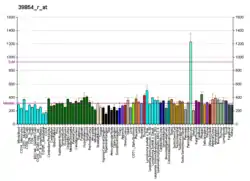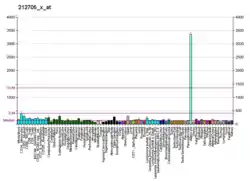Adipose triglyceride lipase
Adipose triglyceride lipase, also known as patatin-like phospholipase domain-containing protein 2 and ATGL, is an enzyme that in humans is encoded by the PNPLA2 gene.[5][6][7][8] ATGL catalyses the first reaction of lipolysis,[9] where triacylglycerols are hydrolysed to diacylglycerols.[10]
Properties
ATGL has very high substrate specificity for triacylglycerols.[11] It contains a catalytic dyad using serine-aspartic acid.[10]
Function
ATGL catalyses the first reaction of lipolysis.[9] It hydrolysis triacylglycerols to diacylglycerols[10] by attacking the fatty acid attached to carbon-3 of glycerol.
ATGL acts as a control mechanism of lipolysis, as variations in diacylglycerol concentration impact enzymes in later stages of lipolysis.[12]
Clinical significance
Defects in ATGL can cause problems in lipolysis, leading to neutral lipid storage disease.[13] As triacylglycerols are not hydrolysed to diacylglycerols, there is a build-up of triacylglycerol droplets in granulocytes.[13]
References
- GRCh38: Ensembl release 89: ENSG00000177666 - Ensembl, May 2017
- GRCm38: Ensembl release 89: ENSMUSG00000025509 - Ensembl, May 2017
- "Human PubMed Reference:". National Center for Biotechnology Information, U.S. National Library of Medicine.
- "Mouse PubMed Reference:". National Center for Biotechnology Information, U.S. National Library of Medicine.
- Andersson B, Wentland MA, Ricafrente JY, Liu W, Gibbs RA (April 1996). "A "double adaptor" method for improved shotgun library construction". Analytical Biochemistry. 236 (1): 107–13. doi:10.1006/abio.1996.0138. PMID 8619474.
- Wilson PA, Gardner SD, Lambie NM, Commans SA, Crowther DJ (September 2006). "Characterization of the human patatin-like phospholipase family". Journal of Lipid Research. 47 (9): 1940–9. doi:10.1194/jlr.M600185-JLR200. PMID 16799181.
- Kienesberger PC, Oberer M, Lass A, Zechner R (April 2009). "Mammalian patatin domain containing proteins: a family with diverse lipolytic activities involved in multiple biological functions". Journal of Lipid Research. 50 Suppl (Supplement): S63-8. doi:10.1194/jlr.R800082-JLR200. PMC 2674697. PMID 19029121.
- "Entrez Gene: PNPLA2 patatin-like phospholipase domain containing 2".
- Ojha S, Budge H, Symonds ME (2014). "Adipocytes in Normal Tissue Biology". In McManus LM, Mitchell RN (eds.). Pathobiology of Human Disease. San Diego: Academic Press. pp. 2003–2013. doi:10.1016/b978-0-12-386456-7.04408-7. ISBN 978-0-12-386457-4.
- Lehner R, Quiroga AD (2016). "Chapter 5 - Fatty Acid Handling in Mammalian Cells". In Ridgway ND, McLeod RS (eds.). Biochemistry of Lipids, Lipoproteins and Membranes (Sixth ed.). Boston: Elsevier. pp. 149–184. doi:10.1016/b978-0-444-63438-2.00005-5. ISBN 978-0-444-63438-2.
- Tsiloulis T, Watt MJ (2015). "Chapter Eight - Exercise and the Regulation of Adipose Tissue Metabolism". In Bouchard C (ed.). Progress in Molecular Biology and Translational Science. Molecular and Cellular Regulation of Adaptation to Exercise. 135. Academic Press. pp. 175–201. doi:10.1016/bs.pmbts.2015.06.016.
- Zhang X, Heckmann BL, Liu J (2013-01-01). Yang P, Li H (eds.). "Studying lipolysis in adipocytes by combining siRNA knockdown and adenovirus-mediated overexpression approaches". Methods in Cell Biology. Lipid Droplets. Academic Press. 116: 83–105. doi:10.1016/b978-0-12-408051-5.00006-1. PMC 4529287. PMID 24099289.
- Bongarzone ER, Givogri MI, Darryl C, DiMauro S (January 2012). "Inborn Metabolic Defects of Lysosomes, Peroxisomes, Carbohydrates, Fatty Acids and Mitochondria.". In Brady ST, Siegel GJ, Albers RW, Price DL (eds.). Basic Neurochemistry (Eighth ed.). New York: Academic Press. pp. 755–782. doi:10.1016/b978-0-12-374947-5.00043-2. ISBN 978-0-12-374947-5.
Further reading
- Yu W, Andersson B, Worley KC, Muzny DM, Ding Y, Liu W, et al. (April 1997). "Large-scale concatenation cDNA sequencing". Genome Research. 7 (4): 353–8. doi:10.1101/gr.7.4.353. PMC 139146. PMID 9110174.
- Colland F, Jacq X, Trouplin V, Mougin C, Groizeleau C, Hamburger A, et al. (July 2004). "Functional proteomics mapping of a human signaling pathway". Genome Research. 14 (7): 1324–32. doi:10.1101/gr.2334104. PMC 442148. PMID 15231748.
- Villena JA, Roy S, Sarkadi-Nagy E, Kim KH, Sul HS (November 2004). "Desnutrin, an adipocyte gene encoding a novel patatin domain-containing protein, is induced by fasting and glucocorticoids: ectopic expression of desnutrin increases triglyceride hydrolysis". The Journal of Biological Chemistry. 279 (45): 47066–75. doi:10.1074/jbc.M403855200. PMID 15337759.
- Jenkins CM, Mancuso DJ, Yan W, Sims HF, Gibson B, Gross RW (November 2004). "Identification, cloning, expression, and purification of three novel human calcium-independent phospholipase A2 family members possessing triacylglycerol lipase and acylglycerol transacylase activities". The Journal of Biological Chemistry. 279 (47): 48968–75. doi:10.1074/jbc.M407841200. PMID 15364929.
- Zimmermann R, Strauss JG, Haemmerle G, Schoiswohl G, Birner-Gruenberger R, Riederer M, et al. (November 2004). "Fat mobilization in adipose tissue is promoted by adipose triglyceride lipase". Science. 306 (5700): 1383–6. doi:10.1126/science.1100747. PMID 15550674. S2CID 33644973.
- Rual JF, Venkatesan K, Hao T, Hirozane-Kishikawa T, Dricot A, Li N, et al. (October 2005). "Towards a proteome-scale map of the human protein-protein interaction network". Nature. 437 (7062): 1173–8. doi:10.1038/nature04209. PMID 16189514. S2CID 4427026.
- Smirnova E, Goldberg EB, Makarova KS, Lin L, Brown WJ, Jackson CL (January 2006). "ATGL has a key role in lipid droplet/adiposome degradation in mammalian cells". EMBO Reports. 7 (1): 106–13. doi:10.1038/sj.embor.7400559. PMC 1369222. PMID 16239926.
- Schoenborn V, Heid IM, Vollmert C, Lingenhel A, Adams TD, Hopkins PN, et al. (May 2006). "The ATGL gene is associated with free fatty acids, triglycerides, and type 2 diabetes". Diabetes. 55 (5): 1270–5. doi:10.2337/db05-1498. PMID 16644682.
- Lass A, Zimmermann R, Haemmerle G, Riederer M, Schoiswohl G, Schweiger M, et al. (May 2006). "Adipose triglyceride lipase-mediated lipolysis of cellular fat stores is activated by CGI-58 and defective in Chanarin-Dorfman Syndrome". Cell Metabolism. 3 (5): 309–19. doi:10.1016/j.cmet.2006.03.005. PMID 16679289.
- Mairal A, Langin D, Arner P, Hoffstedt J (July 2006). "Human adipose triglyceride lipase (PNPLA2) is not regulated by obesity and exhibits low in vitro triglyceride hydrolase activity". Diabetologia. 49 (7): 1629–36. doi:10.1007/s00125-006-0272-x. PMID 16752181.
- Notari L, Baladron V, Aroca-Aguilar JD, Balko N, Heredia R, Meyer C, et al. (December 2006). "Identification of a lipase-linked cell membrane receptor for pigment epithelium-derived factor". The Journal of Biological Chemistry. 281 (49): 38022–37. doi:10.1074/jbc.M600353200. PMID 17032652.
- Fischer J, Lefèvre C, Morava E, Mussini JM, Laforêt P, Negre-Salvayre A, et al. (January 2007). "The gene encoding adipose triglyceride lipase (PNPLA2) is mutated in neutral lipid storage disease with myopathy". Nature Genetics. 39 (1): 28–30. doi:10.1038/ng1951. PMID 17187067. S2CID 23679419.
- Rydén M, Jocken J, van Harmelen V, Dicker A, Hoffstedt J, Wirén M, et al. (June 2007). "Comparative studies of the role of hormone-sensitive lipase and adipose triglyceride lipase in human fat cell lipolysis". American Journal of Physiology. Endocrinology and Metabolism. 292 (6): E1847-55. CiteSeerX 10.1.1.328.3523. doi:10.1152/ajpendo.00040.2007. PMID 17327373.
- Jocken JW, Langin D, Smit E, Saris WH, Valle C, Hul GB, et al. (June 2007). "Adipose triglyceride lipase and hormone-sensitive lipase protein expression is decreased in the obese insulin-resistant state". The Journal of Clinical Endocrinology and Metabolism. 92 (6): 2292–9. doi:10.1210/jc.2006-1318. PMID 17356053.
- Steinberg GR, Kemp BE, Watt MJ (October 2007). "Adipocyte triglyceride lipase expression in human obesity". American Journal of Physiology. Endocrinology and Metabolism. 293 (4): E958-64. doi:10.1152/ajpendo.00235.2007. PMID 17609260.
- Fischer J, Negre-Salvayre A, Salvayre R (2007). "[Neutral lipid storage diseases and ATGL (adipose triglyceride lipase) and CGI-58/ABHD5 (alpha-beta hydrolase domain-containing 5) deficiency: myopathy, ichthyosis, but no obesity]". Médecine/Sciences. 23 (6–7): 575–8. doi:10.1051/medsci/20072367575. PMID 17631826.
External links
- Human PNPLA2 genome location and PNPLA2 gene details page in the UCSC Genome Browser.





